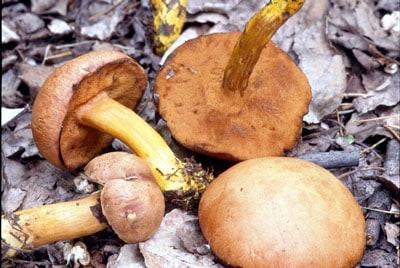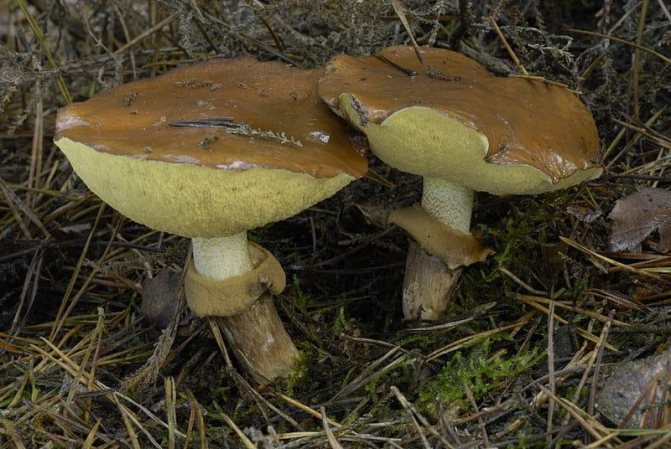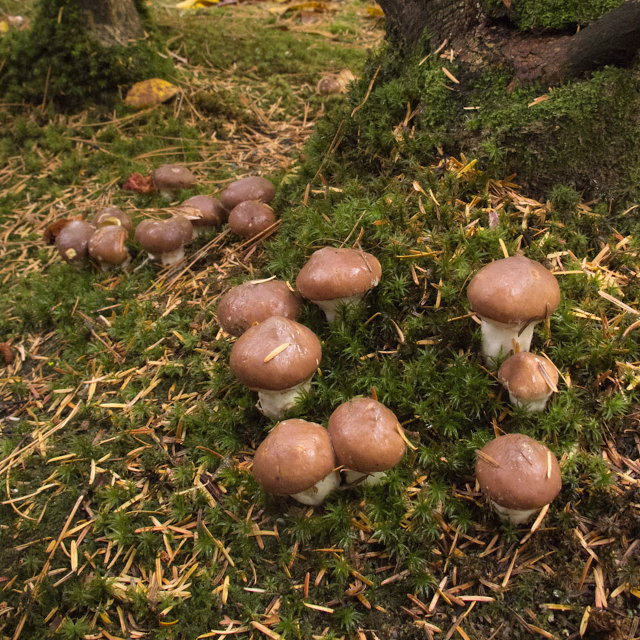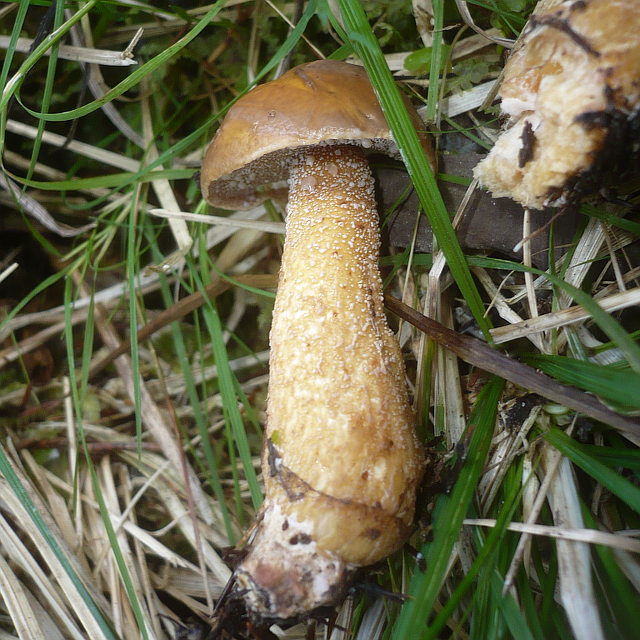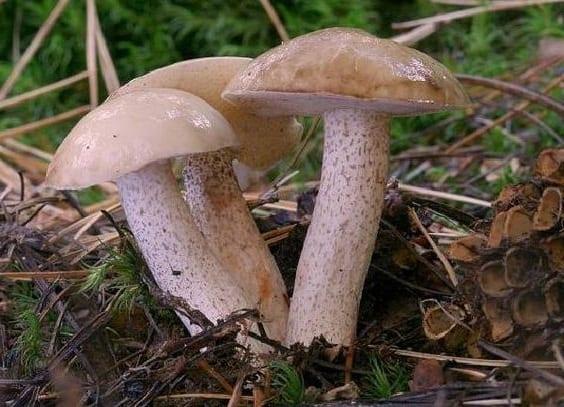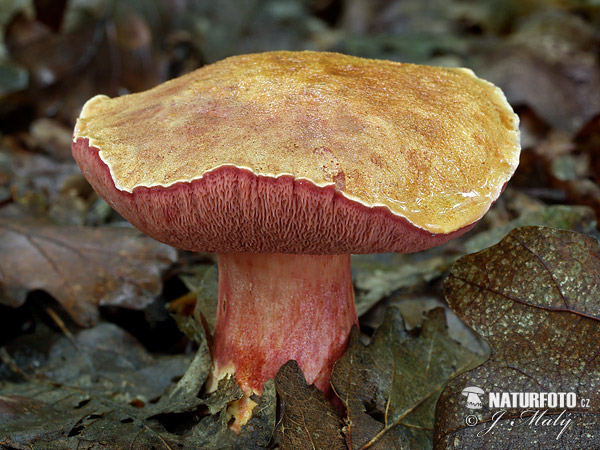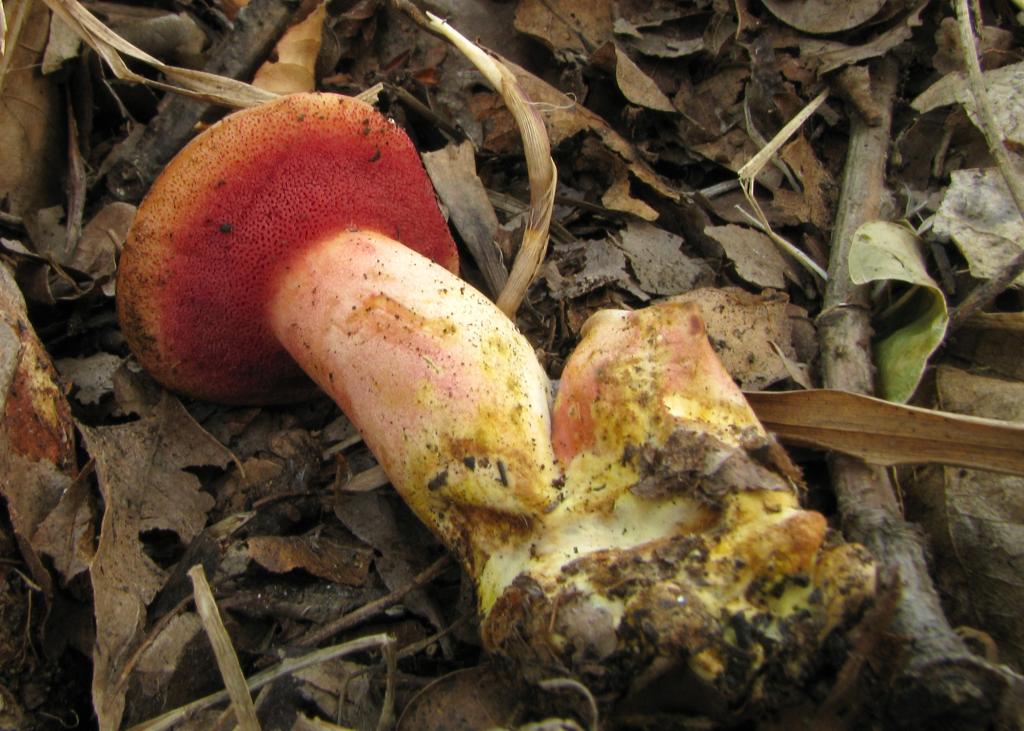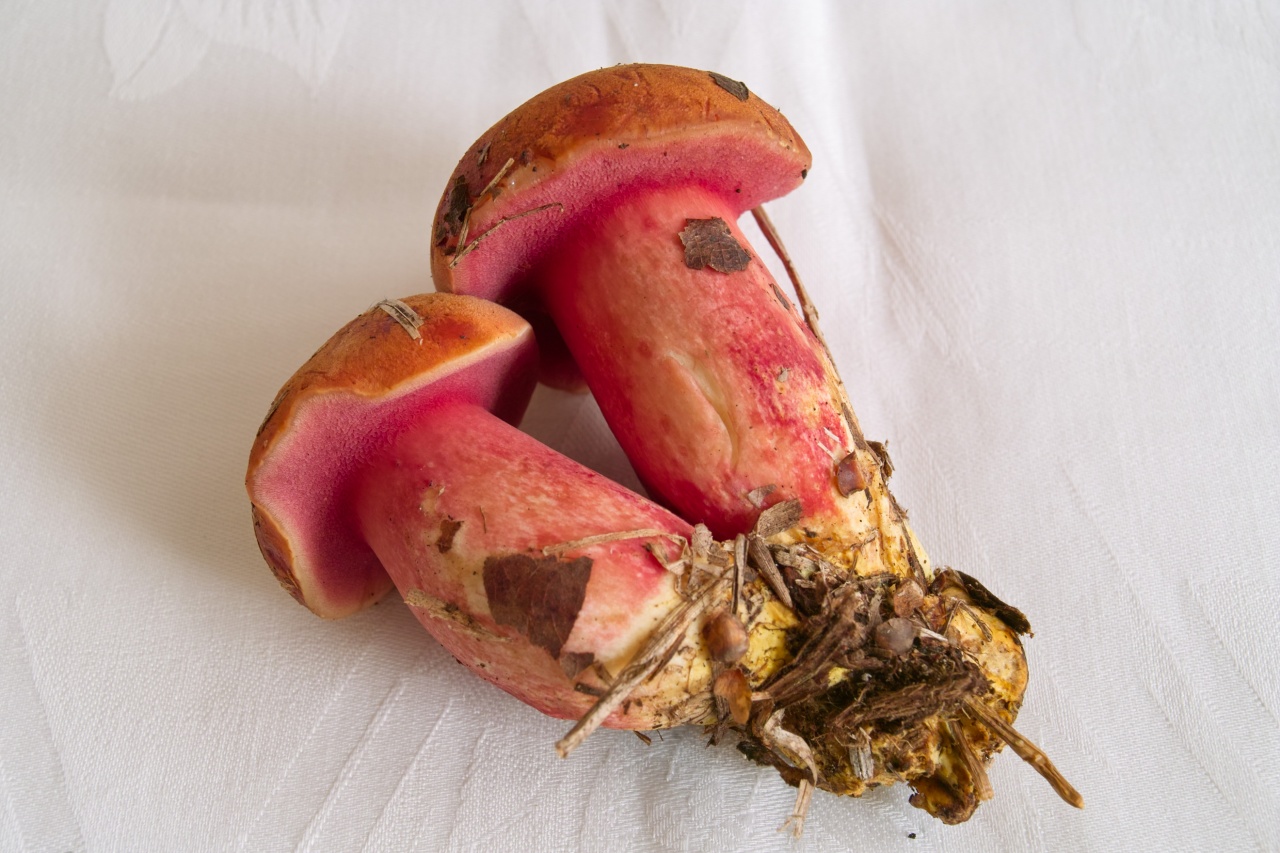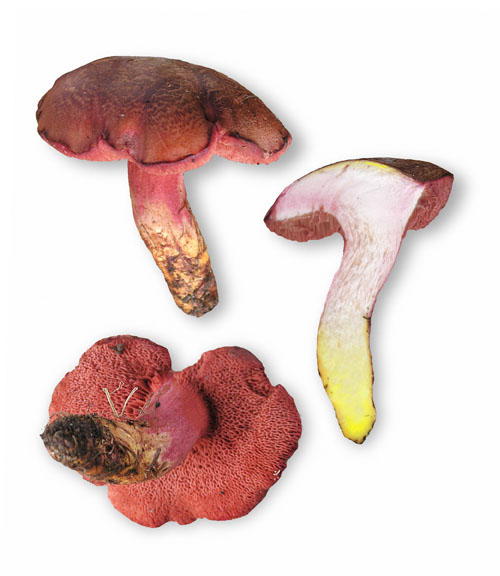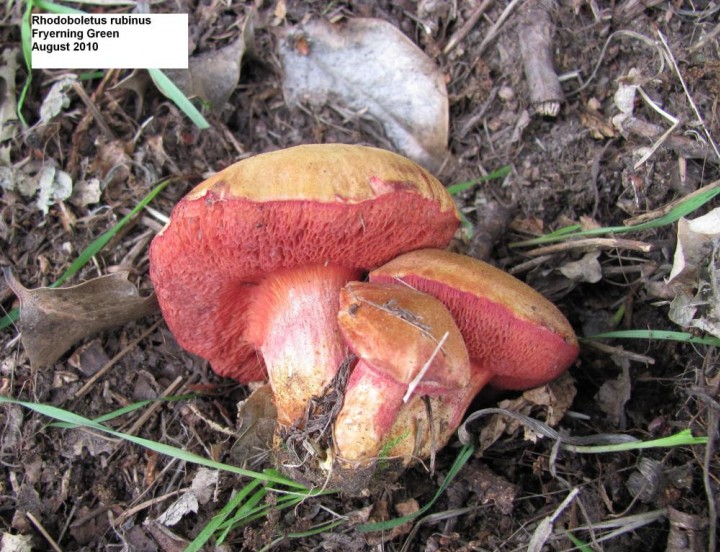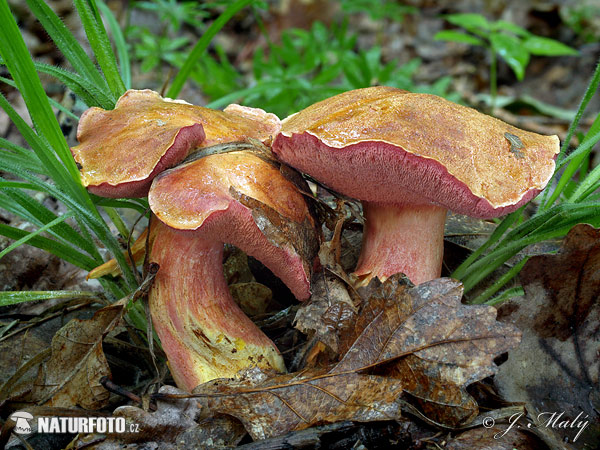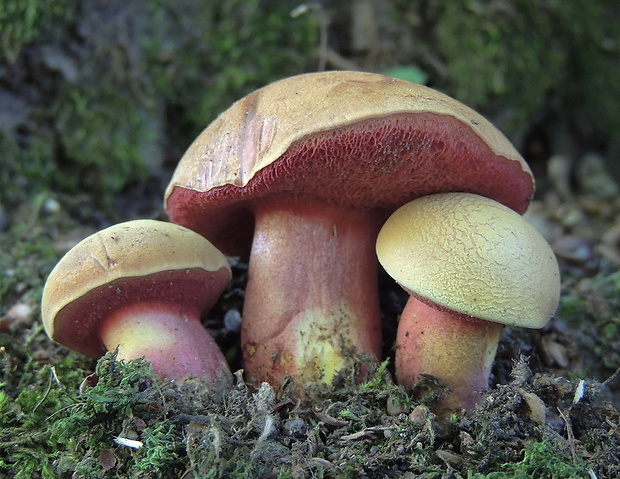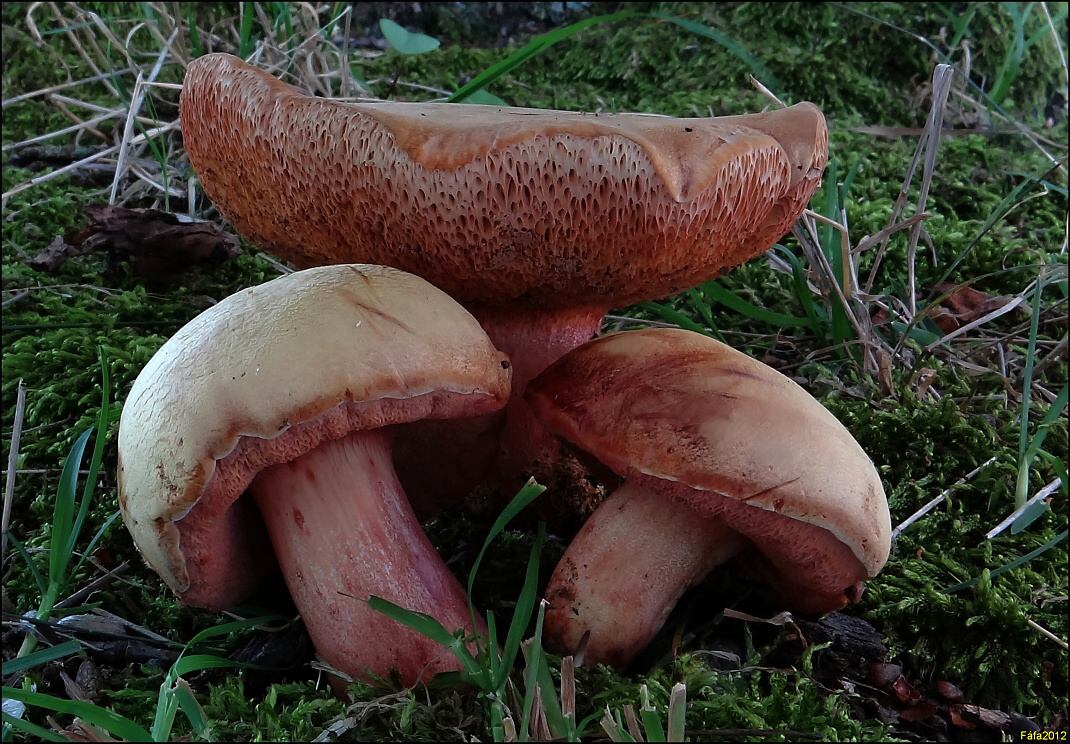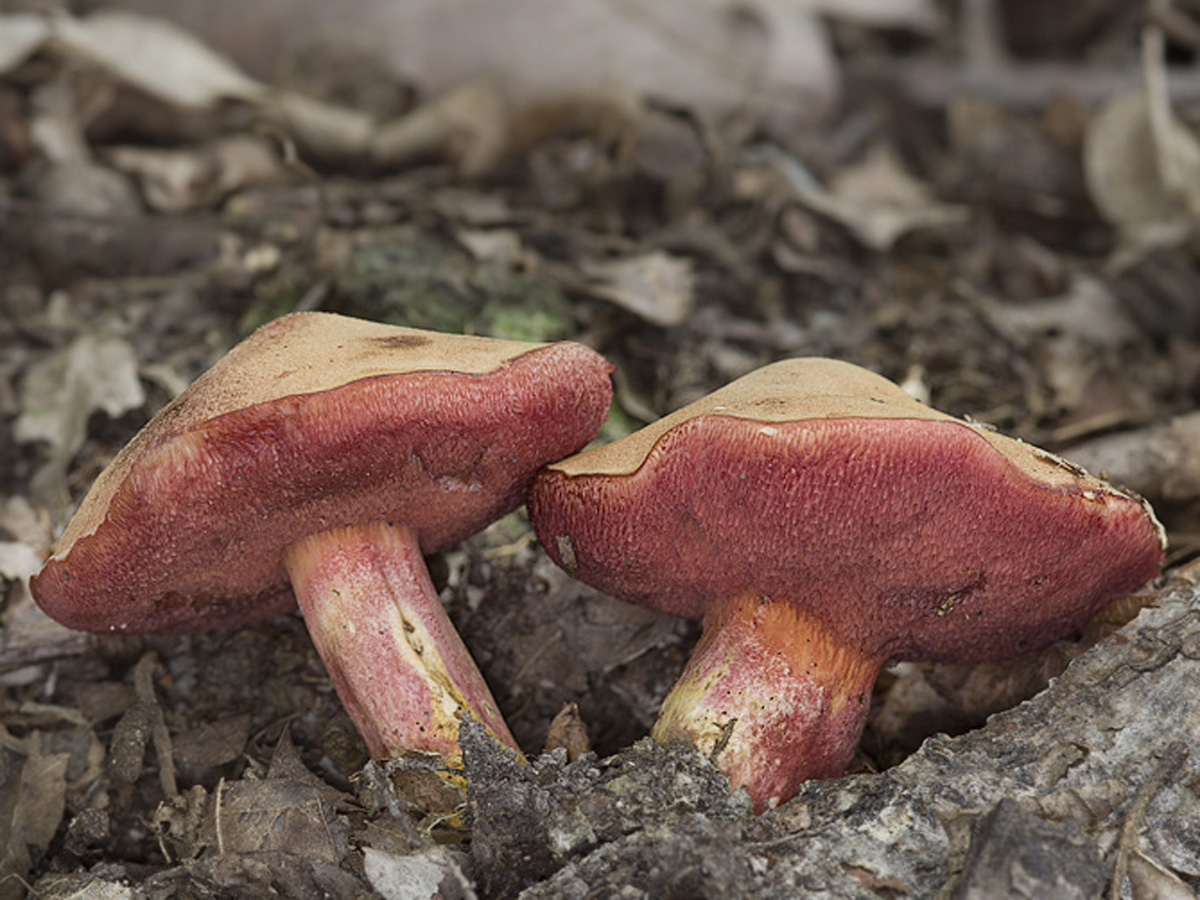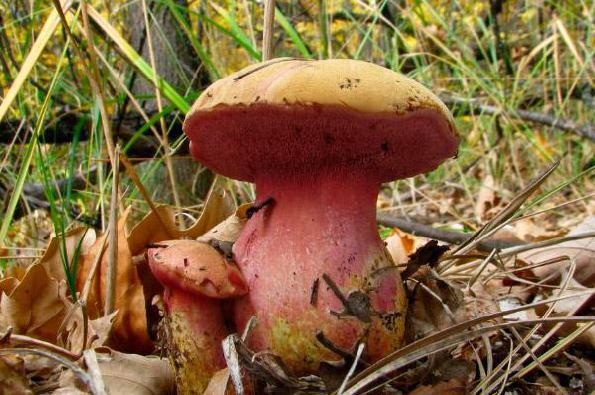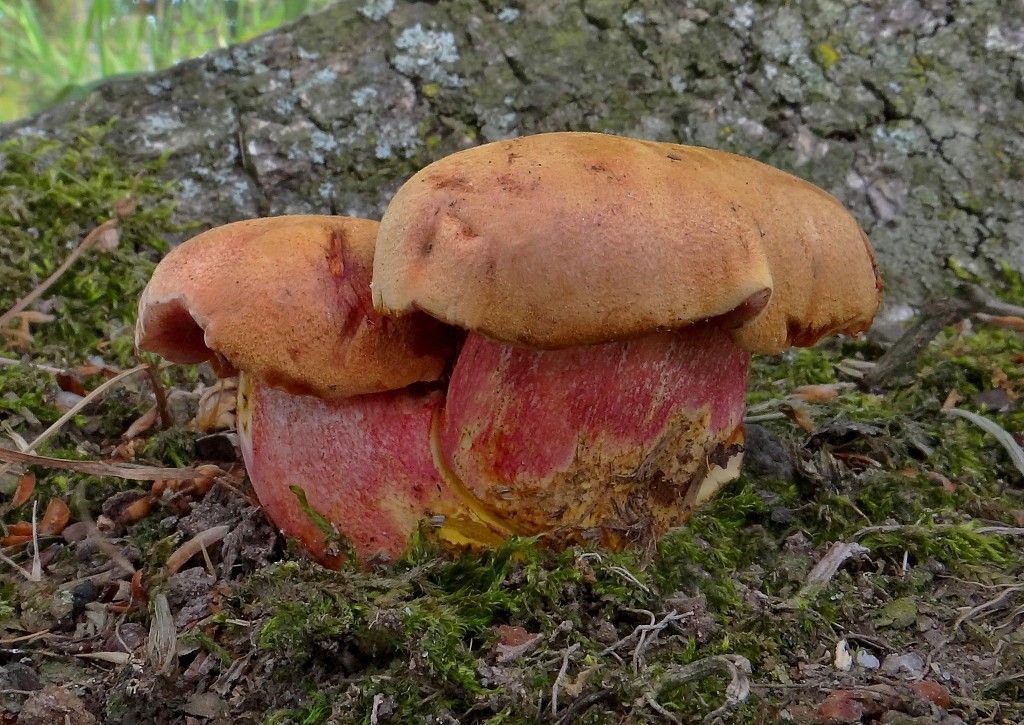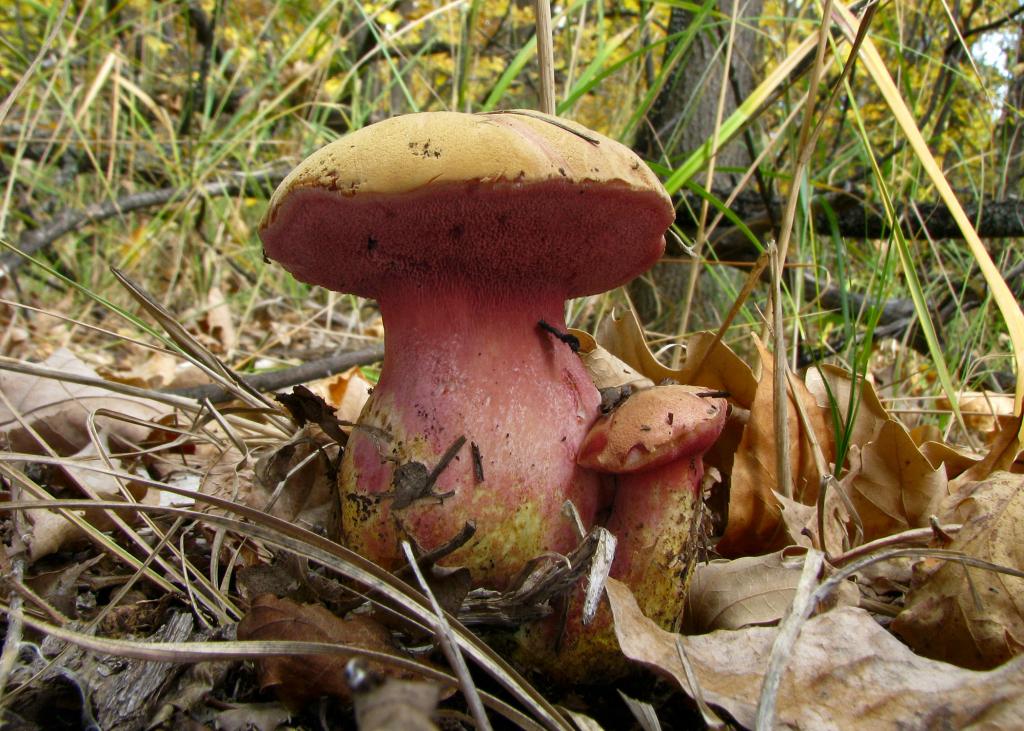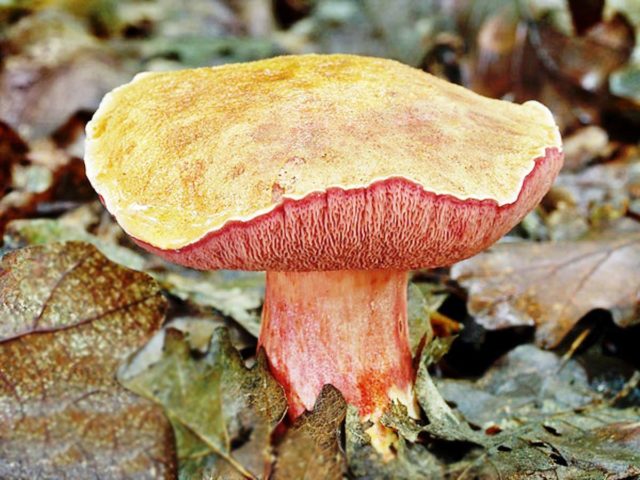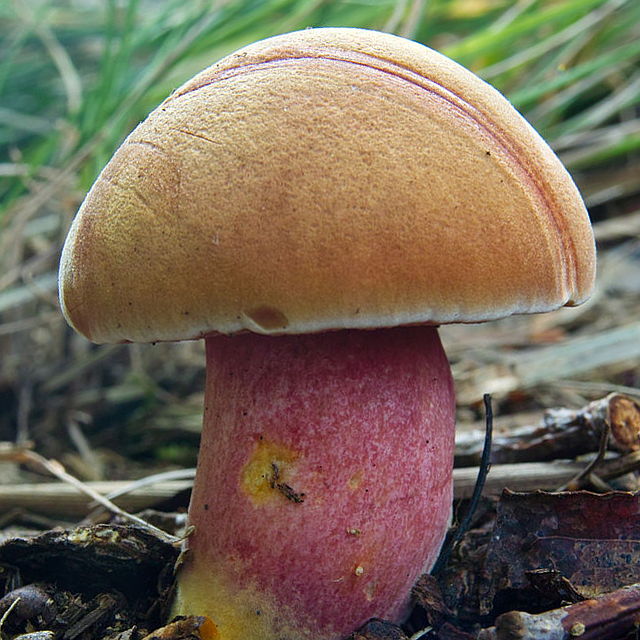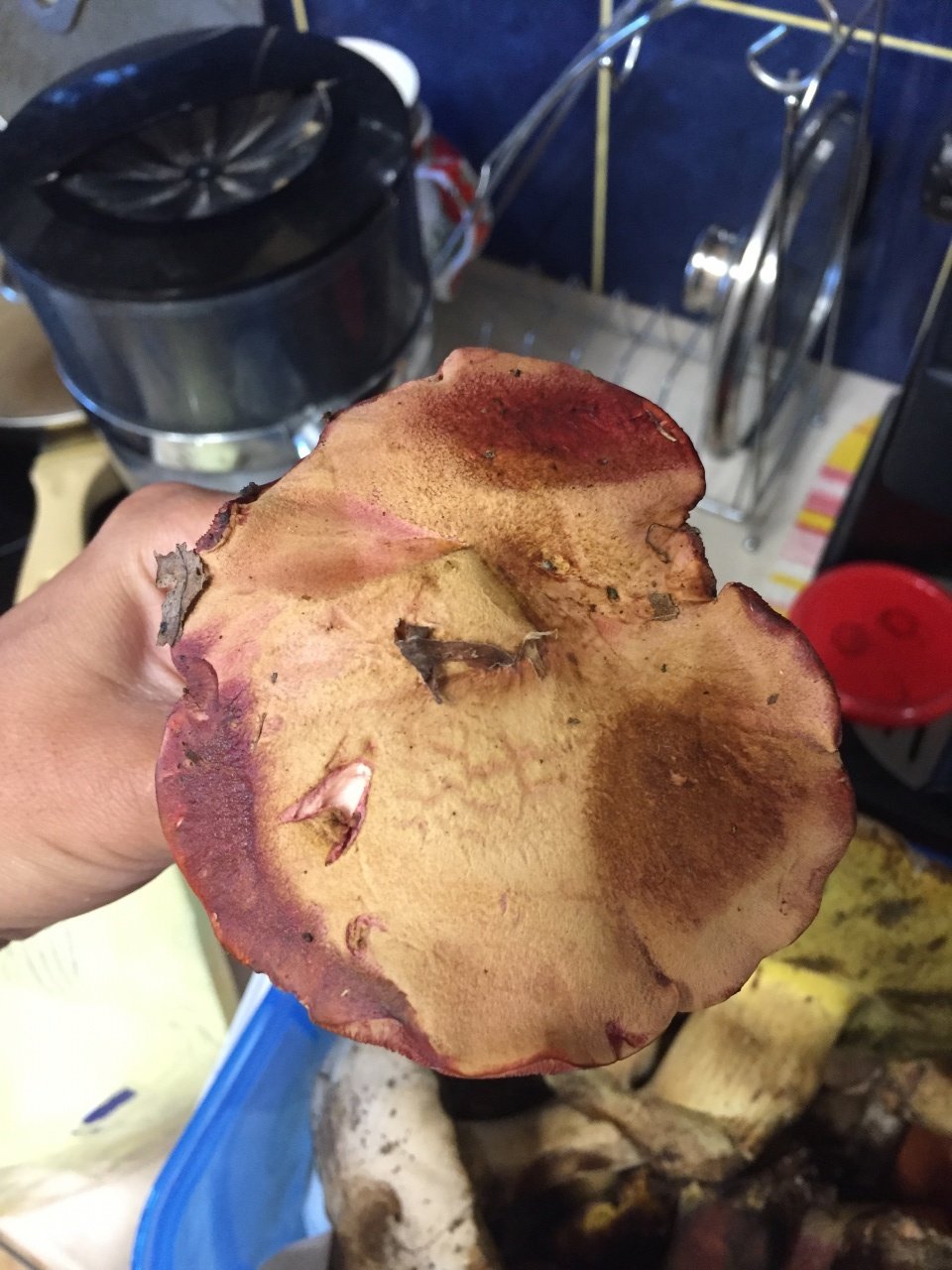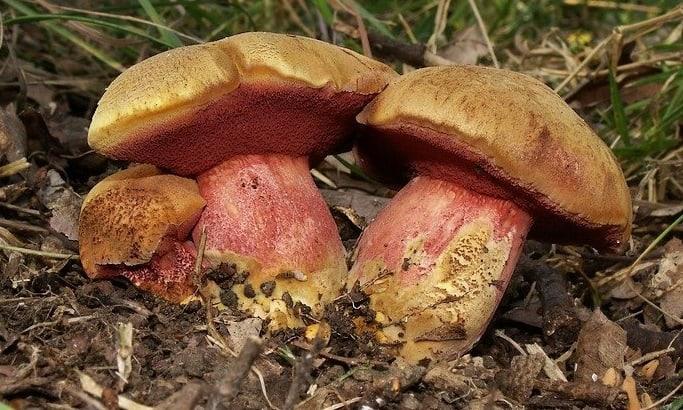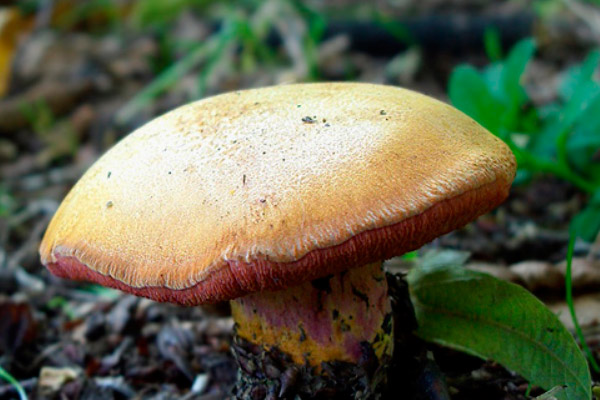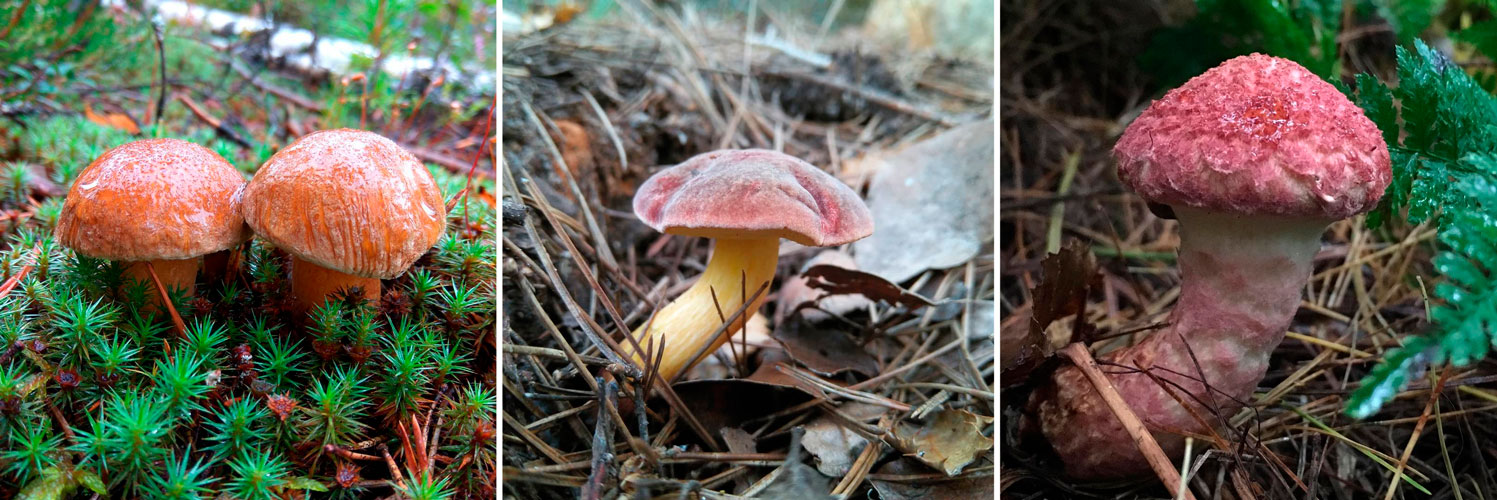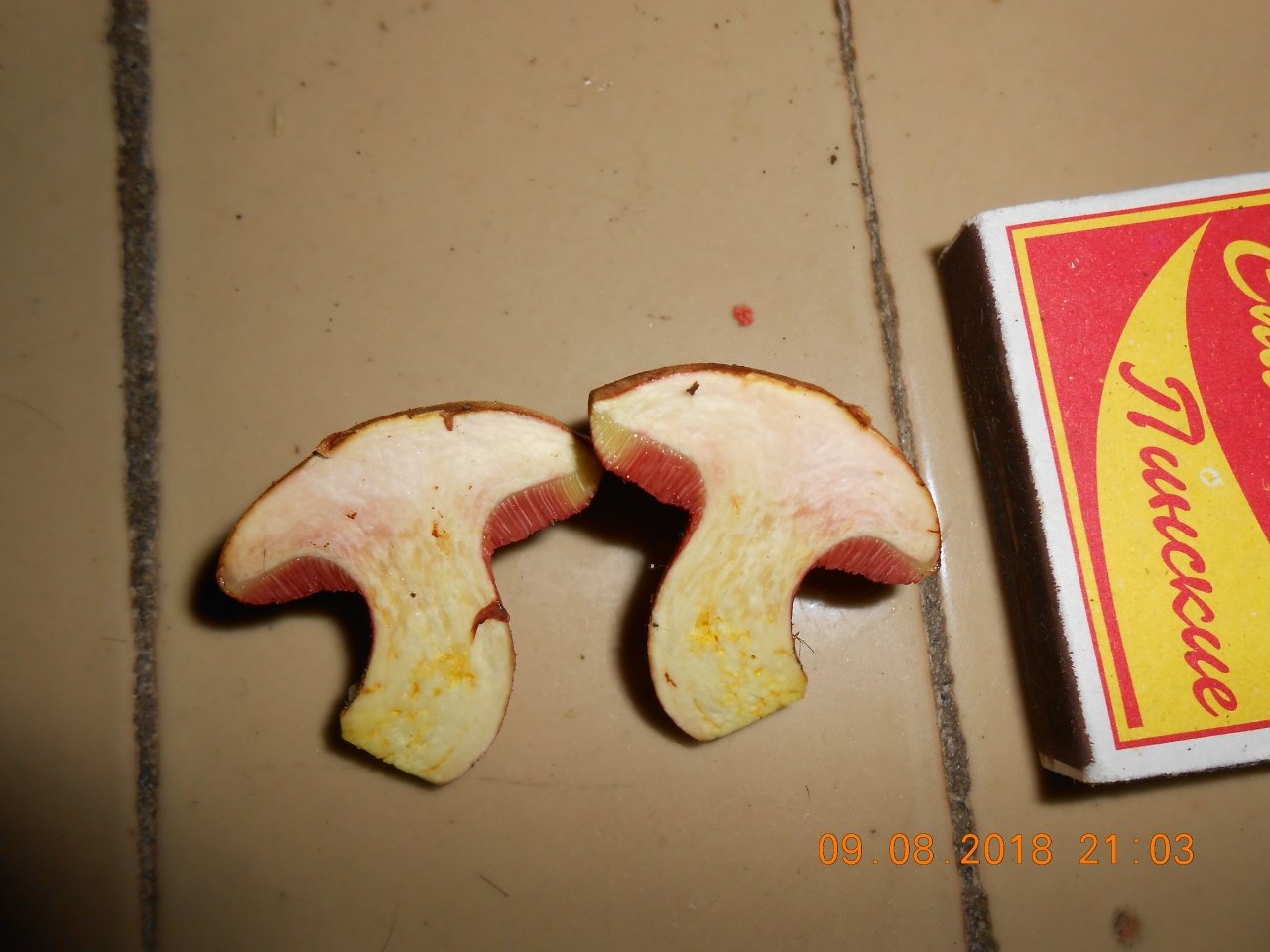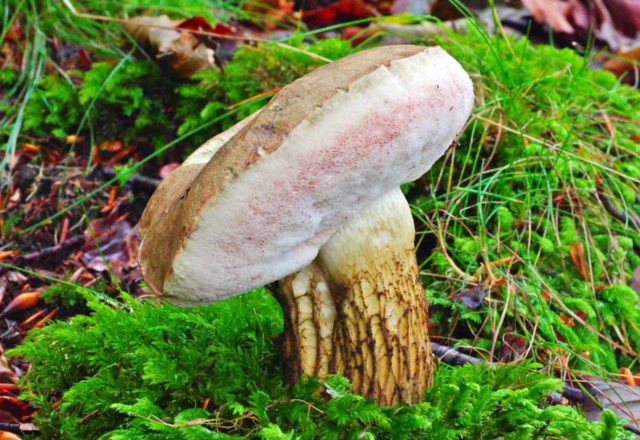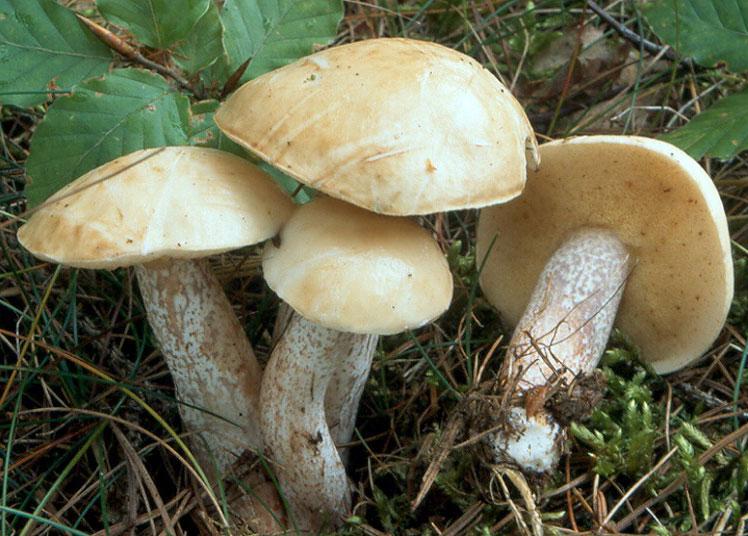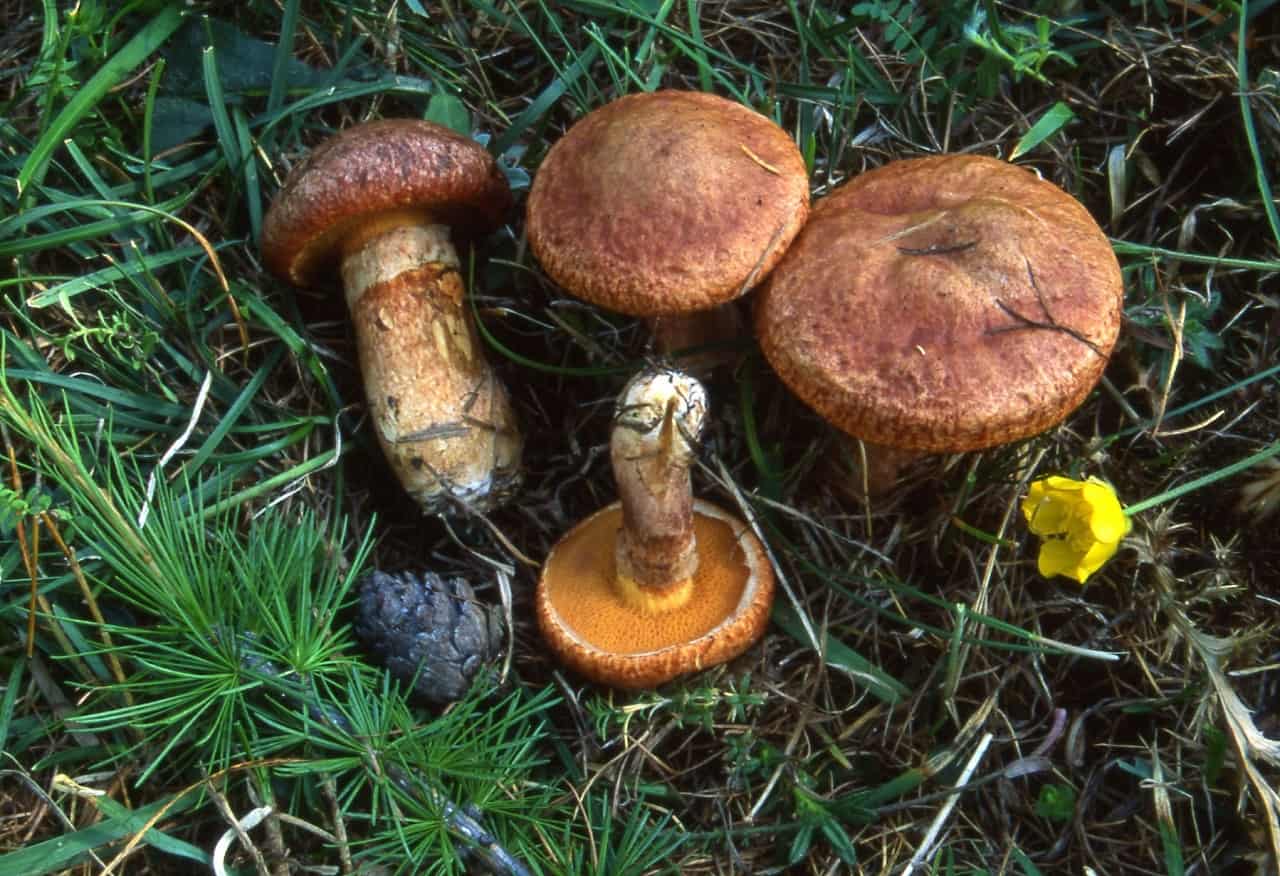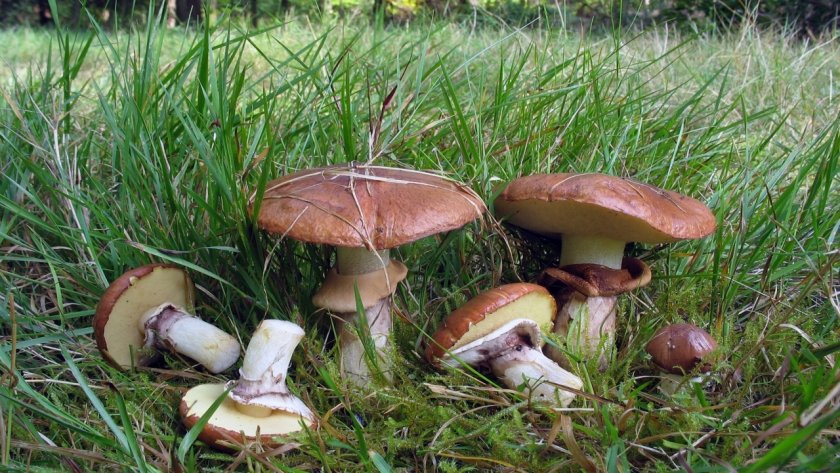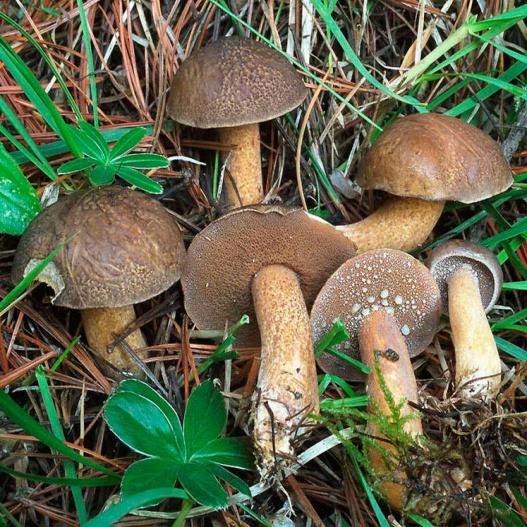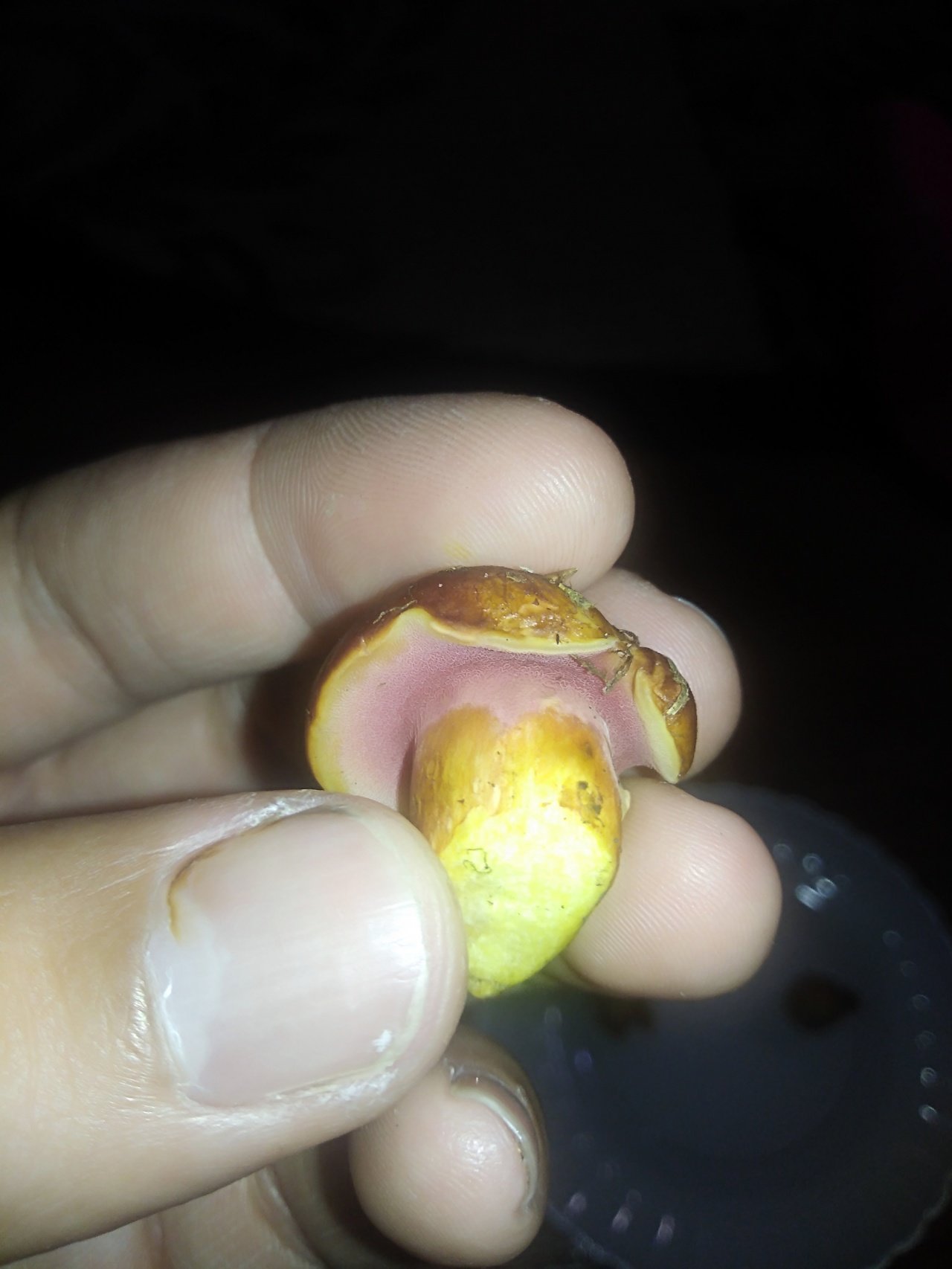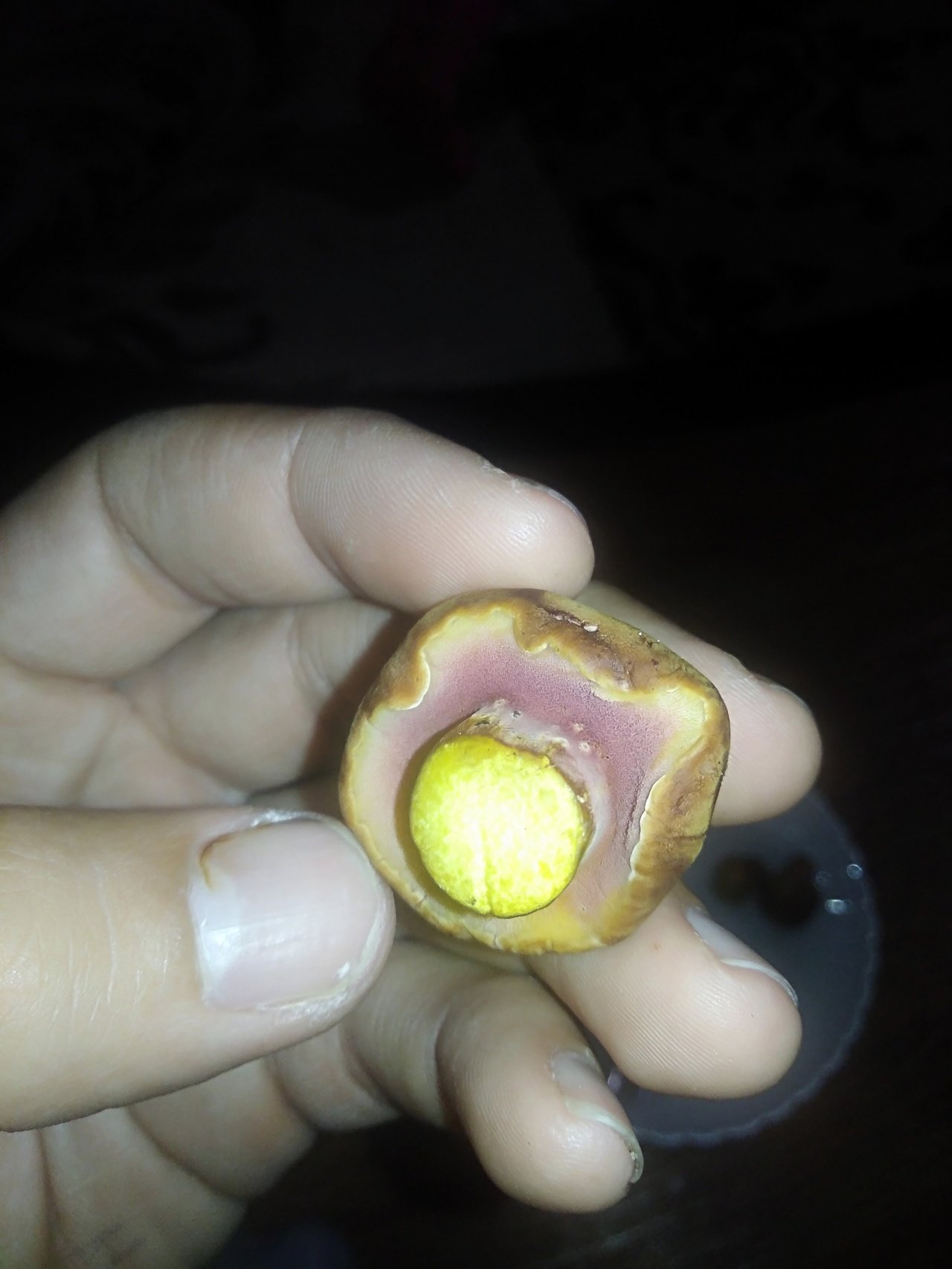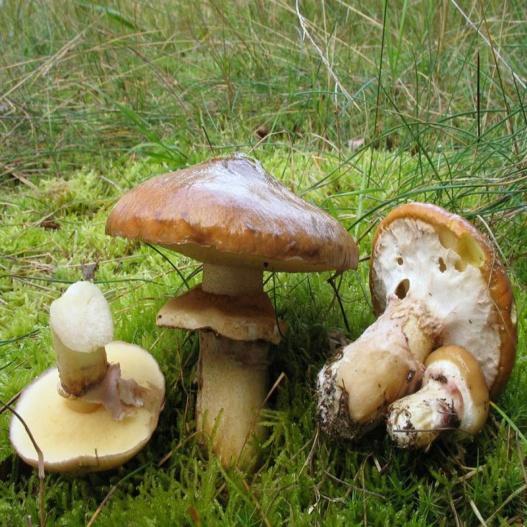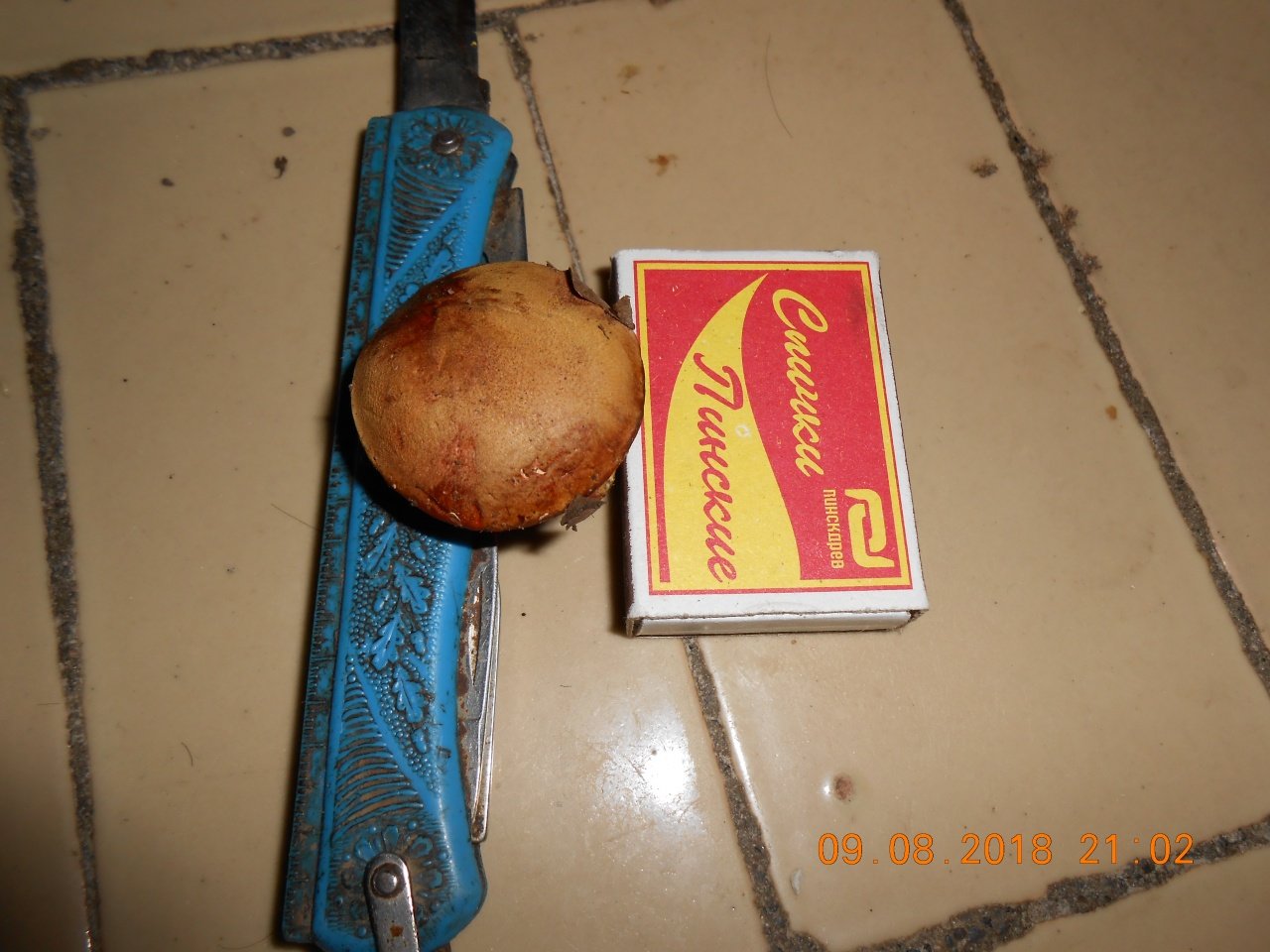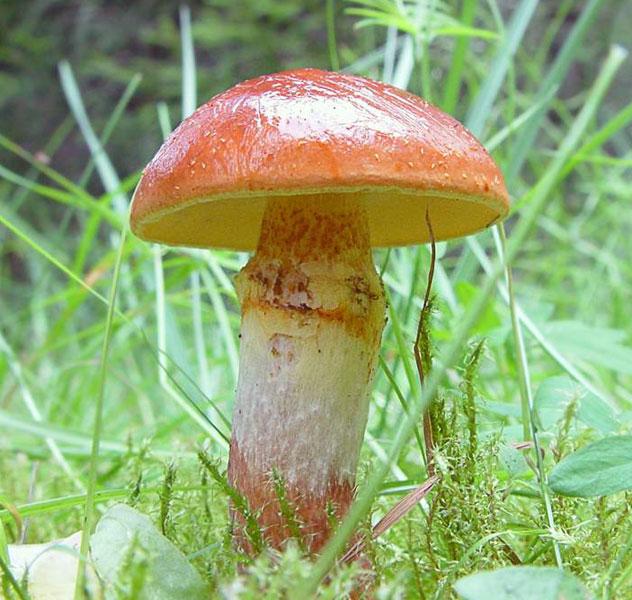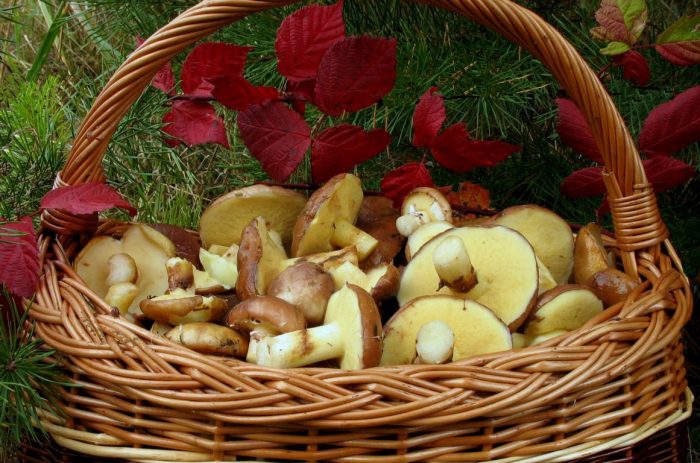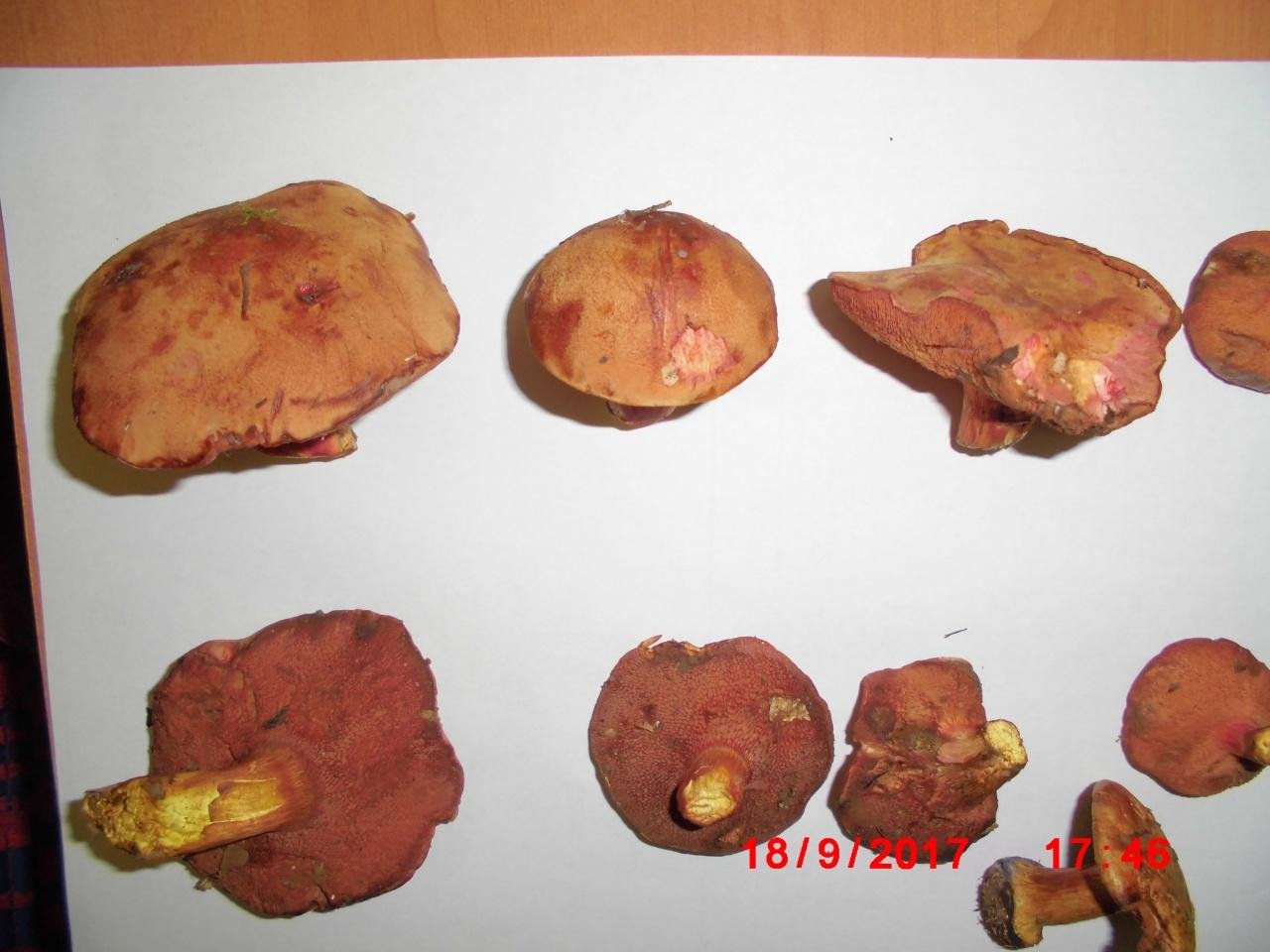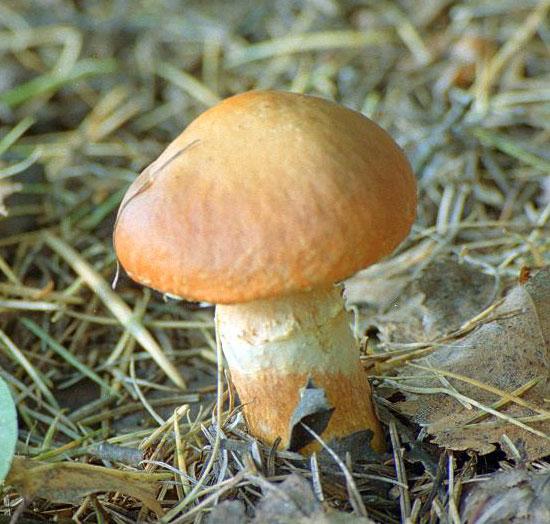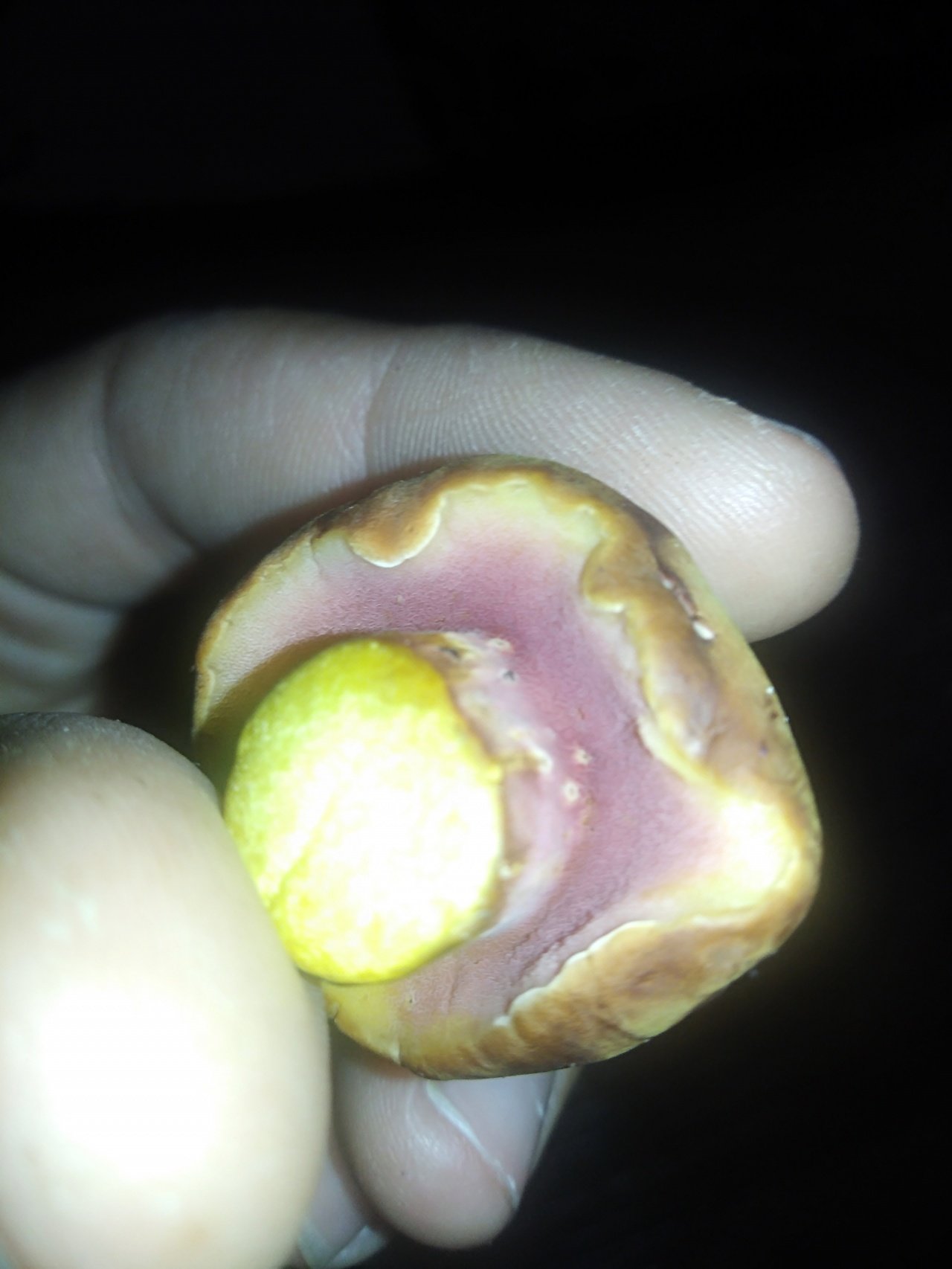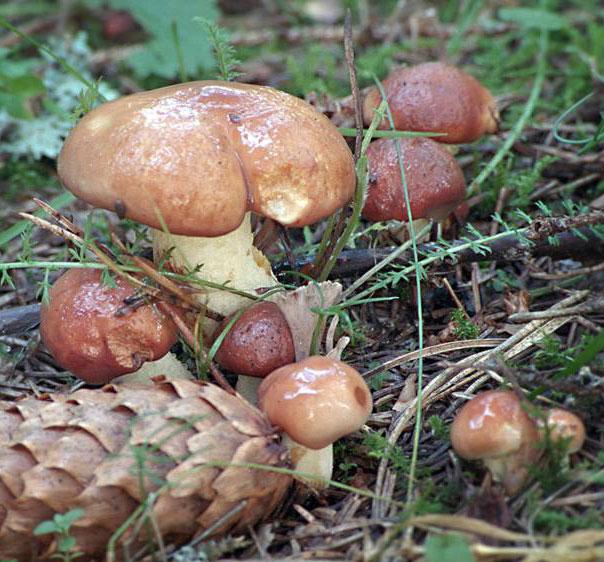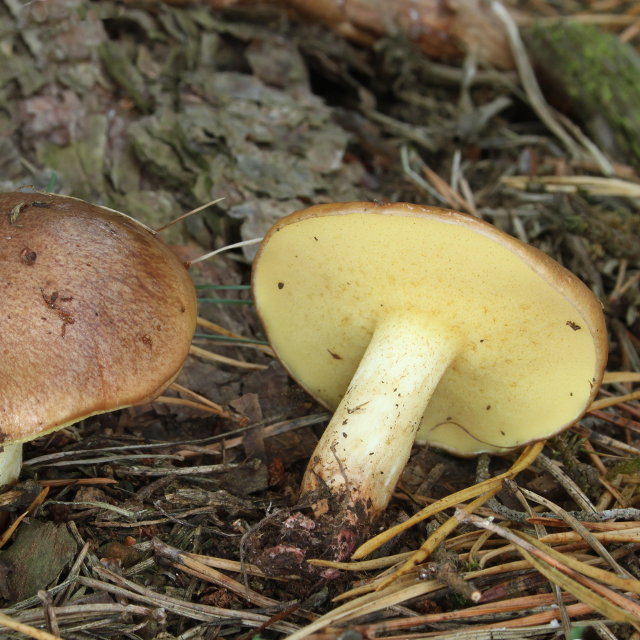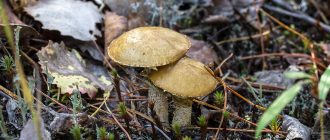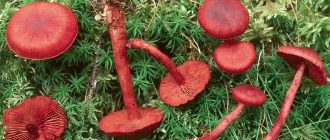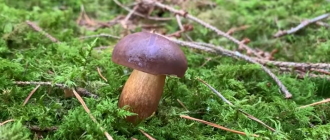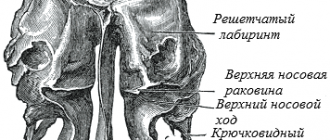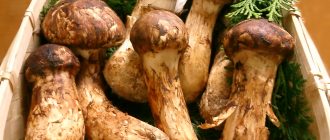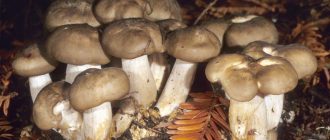Butter dish red
Red oil can - Latin Suillus collinitus
In another way, this fungus is called the unordered Butter.
Description
Mushroom cap
The non-ringed oiler grows caps with a diameter of 35-11 cm. In youth, they are hemispheres, after which they become convex - outstretched. In old age, hats spread even more, and their edges often begin to bend up, and the middle - to be pressed in.
The “headgear” is covered with an easily detachable smooth, dryish sticky skin, which is covered with mucus at a young age and in rainy season. The skin is colored in a reddish, reddish, brown - chestnut or brown hue, and is covered with dark fibers.
At first, the hats are filled with dense, then - with a delicate and loose light yellow pulp, which does not change color when pressed or damaged.
The hat bottom has a tubular structure and consists of tubes growing or slightly descending along the legs. Young mushrooms have a light yellow tubular layer, grown ones - a rich yellow, older ones - dark yellow or yellow - olive. If you press on it or cut it with a knife, it turns brown.
Rufous oillet reproduces by pale yellow smooth elongated spores stored in ocher-brown spore powder.
Stipe
Red boletus have cylindrical solid legs, growing up to 1-3 cm in thickness and 2-7 cm in length. The leg, evenly thickened or tapering (thickening) downwards, is located in the center of the cap and is painted in a pale yellow or rich yellow tone, turning pink towards the base. There is no ringlet on the legs.
On the foot surface of young fungi, yellowish granules are present, which in the future acquire a brown-red or brown color. During rains, the base of the leg becomes deep pink, in drought it fades to almost white. The leg is filled with whitish or light yellow pulp, turning pink downwards.
Red oil can - Latin Suillus collinitus
Places of growth and fruiting
Non-ringed oiler prefers a soil substrate of mixed forests and conifers with pines, spruces and larch trees, and in southern countries - with pine and cypress.
Fruiting occurs in waves, in three steps, from June to October, and, for example, in Israel it is harvested even in December and February.
In Russia, boletus trees are born in early - mid-June, when the pine tree blooms: there are especially many of them under young Christmas trees and pines. The second wave occurs in mid - late July, when the forest lindens bloom. For the third time, mushroom pickers go for a tasty trophy in August - September, until the first severe frosts come.
The mushroom bears fruit in large families, but it can also be found singly.
Edibility
Non-ringed butterflies attract gourmets with a delicate sweetish taste and a dull, but surprisingly pleasant mushroom aroma. They belong to the 2nd category of edibility and are used in salted, pickled, fried and boiled form, in soups and sauces.
Boiled mushrooms acquire a soft creamy color, pleasant to the eye. The main thing is to collect non-wormy mushrooms and remove the skin from them, which secretes mucus during cooking: it makes the pulp black and disgusting in appearance.
You can dry butter without removing the skin: the caps will darken during drying and cooking, even without it.
Is the mushroom edible or not?
Pepper mushroom is not used as a separate dish, but if dried and crushed, it makes a wonderful seasoning. Dried fruits can be used to make hot sauces. It is usually used in small quantities and is not very popular with mushroom pickers.
There are opinions that with prolonged cooking, you can completely get rid of the peppery taste, but is it worth the risk and waste time cooking mushrooms that will not bring gastronomic pleasure?

In what cases is mushroom poisoning possible?
Poisoning with a pepper flywheel is possible when it is improperly cooked. Fruiting bodies contain chitin, which is difficult for the body to digest and can provoke a severe disorder. Also, pepper mushroom is not recommended for children under 12 years old.
Pregnant and lactating women should refrain from eating any mushrooms. In addition, various diseases of the internal organs, especially the liver and gastrointestinal tract, are an undeniable reason for refusing to collect and use them for food.
Most often, this type of forest harvest is used by mushroom pickers in a mixture with others, and therefore it will not work to eat a large amount that caused a sharp poisoning.
Seasoning preparation
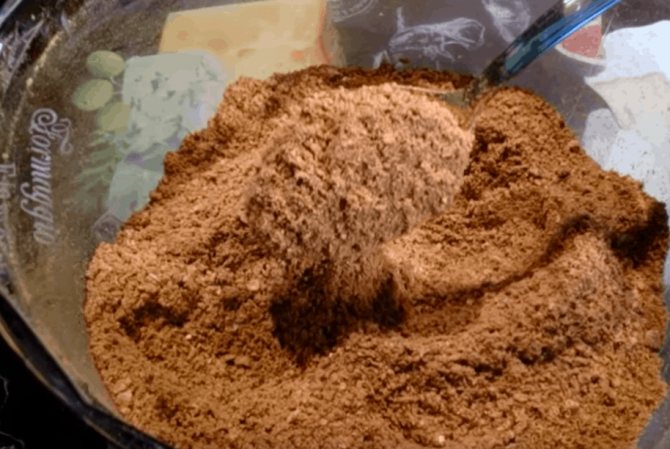
Here is a recipe for making a pepper oil can as a seasoning:
- First of all, the mushrooms should be washed and dried.
- Then cut or break the caps and legs with your hands and boil. In order to remove the unpleasant taste, they should be cooked for at least 2 hours. It is often advisable to change the water while cooking.
- Then let the mushrooms drain and place on a baking sheet on top of baking paper or on foil.
- Dry for about 4 hours, while turning over from time to time. It will take a long time to prepare the seasoning, but the result will exceed all expectations.
When finished, the mushroom will crumble in your hands. For grinding, it is convenient to use a coffee grinder, and then dry it again in the oven for about half an hour. The seasoning should be stored in a hermetically sealed jar. It is used for soups, side dishes and meats. Further processing of the mushroom is not required. Do not leave the seasoning in the sun or in a warm place.
False doubles
Pepper can itself is considered inedible because its pungent taste cannot be completely eliminated, but it makes a good seasoning for dishes that can be used in place of red pepper. What a pepper mushroom looks like can be seen in more detail in the photo, as well as compare it with doubles.
It is easy to distinguish them, the main thing is to understand that all similar inhabitants of the forest kingdom have their own characteristics and characteristics that correspond only to them. The twins of the flywheel are often greenfinches, a kid, but these are different types.
| Name | Hat and hymenophore | Leg | Place of growth | Danger |
| Pepper mushroom
|
Dark brown with a reddish tint | Matches the color of the cap | Pine forest, less often other conifers | Inedible |
| Goat
|
The body is larger, brown, no reddishness, the taste is not spicy | Lighter than a hat | Coniferous forest, more often pine forests | Edible |
| Autumn oil can
|
The hat is light brown, red, the hymenophore is yellow | The color is much lighter than the cap | Coniferous and mixed forests | Edible |
The pepper mushroom has no obviously poisonous counterparts, but still you should not collect it in the forest, it is better to look for more useful species.
Butterlets (Suillus). Description, distribution and types of oil
Good day, dear visitors of the "Well IS!" Project, the "Floristics" section!
It's already the middle of summer, which means that the "mushrooming" begins! And to remind you of some useful information about mushrooms, today we will talk with you about boletus. How can we live without them, in our native forests? Indeed, in terms of popularity and taste, boletus are not particularly inferior to their "white" fellow citizens, who, moreover, are their relatives. So…
Butter dish (Latin Suillus) is a genus of tubular mushrooms of the Boletovye family (Latin Boletaceae).
Category: edible mushrooms.
The oiler got its name from the cap that is oily (slippery) to the touch.
The main difference between the oiler and other painful mushrooms is the cap, which is slippery to the touch, from which the skin can be easily removed. In addition, under the cap there may be a light coverlet, which in adult mushrooms leaves only a trace of its early presence at the top of the stem.
Description oiler
The oiler has a smooth cap, from convex to flat in shape, the surface of which is usually sticky or slimy, with an easily peeled skin. There may be a private cover under the hat.
The hymenophore (the porous part of the flesh of the cap) is easily separated from the cap, seemingly yellow or white, adherent or descending along the stem.
The stem is solid, smooth or grainy, sometimes with a ring (remnants of a private bedspread).
The flesh is whitish or yellowish; on the cut it can change color, from blue to red.
Spore powder of various shades of yellow.
Spreading Oiler
All types of oil are mycorrhizal formers with conifers, mainly with double or five-coniferous pines and larch trees.
Most of the boletus species are found in the temperate zone of the Northern Hemisphere, although native and introduced species are found in many regions of the world, and even on continents such as Africa and Australia.
Useful properties of the oiler
The butter dish is rich in vitamins B2, B6. These mushrooms also contain fiber, carbohydrates, amino acids, fat-like substances - fatty acids, essential oils, and lecithin, which prevents the deposition of cholesterol. In addition, boletus relieves acute headache, because they have a special resinous substance. When using the oil can, the effect of accelerated excretion of uric acid is also noticed, which helps in the fight against gout.
The calorie content of butter is 19.2 kcal.
Nutritional value of butter: proteins - 0.9 g, fats - 0.4 g, carbohydrates - 3.2 g.
Caution, boletus!
In addition to useful properties, boletus has some negative effects on the body. So, the fiber in the oiler is saturated with chitin, which interferes with the good digestibility of these mushrooms. Therefore, it is not recommended to use a large amount of oil can. Experts say that chitin is not only not digested in the human gastrointestinal tract, but also makes it difficult for digestive juices and digestible substances to access. The digestibility of mushrooms will deteriorate, in particular, also by the fact that mushroom proteins mainly belong to difficultly soluble substances.
Doctors consider mushrooms to be difficult to digest.
What to do with boletus?
Butterlets can be prepared in the following ways:
- to extinguish; - cook; - fry; - pickle; - salt; - dry.
The most delicious are fried and pickled butter.
Types of butter
The genus Oiler unites about 50 species of mushrooms.
In view of the peculiarities of morphology, some taxonomists classify the genus of boletus (Suillus) to the family of moss (lat.Gomphidiaceae), or altogether separate it into a separate family of Suillaceae.
Below, for convenience, I have divided the types of butter into 3 categories, depending on the edibility.
Edible species:
Oiler ordinary, oily can late, oily can yellow, oily can, autumn oily (Suillus luteus).
Bellini butter dish (Suillus bellinii).
Belted butter dish (Suillus clintonianus).
Butter dish is marsh, butter dish yellowish (Suillus flavidus).
Granular butter dish, summer butter dish (Suillus granulatus).
Butter dish is white, butter dish is pale, butter dish is soft (Suillus placidus).
Cedar butter dish (Suillus plorans).
Ruby butter dish (Suillus rubinus).
Red-red butter dish (Suillus tridentinus).
Butter dish yellow-brown, swamp butter dish (Suillus variegatus).
Conditionally edible species
Larch Butter (Suillus grevillei (Suillus elegans)).
Greyish oiler, blue larch oiler (Suillus aeruginascens).
Goat, sieve (Suillus bovinus).
Yellowish butter dish (Suillus salmonicolor).
Inedible species
Peppercorn, pepper mushroom (Suillus piperatus).
Siberian butter dish (Suillus sibiricus).
Notable butter dish (Suillus spectabilis).
Growing and care
After planting, it is necessary to provide proper care for the raspberries. It comes down to regular watering, weeding, fertilizing, pruning, mulching, preparing for winter.
Watering
Water the Bryansk ruby as needed. Despite its resistance to droughts, it is better not to allow the topsoil to dry out. In the hot season, watering should be done up to 2 times a week, especially during the period of flowering and fruit setting.
To prevent the soil from drying out, raspberry bushes are well mulched (with straw, hay, peat). Do this after abundant watering.Mulch not only retains moisture, but also inhibits the growth of weeds, overcooking, nourishes the earth with organic substances.
Pruning
To prevent a decrease in yield, crushing the berries, raspberries are carefully cut off. In the fall, remove all fertile stems, as well as excess young growth.
During spring pruning, frozen and dried stems are removed, and healthy ones are cut by 10 cm. The latter measure improves productivity, stimulates the growth of lateral fruiting shoots.
Top dressing
For the first 2 years, raspberries have enough nutrients introduced during planting. Feeding begins in the third year of the life of young shoots. In spring, shoots need nitrogen. Diluted chicken manure, mullein, or store-bought preparations - urea, saltpeter are introduced. The latter are scattered under the bushes before the rain, or they are obligatory abundant watering.
Before fruiting, the culture is fertilized with specialized complex compounds containing potassium. This macronutrient promotes more efficient fruit setting and ripening.
After harvesting, the raspberry plant is fed with phosphorus-containing preparations, which allow the culture to prepare well for the dormant period.
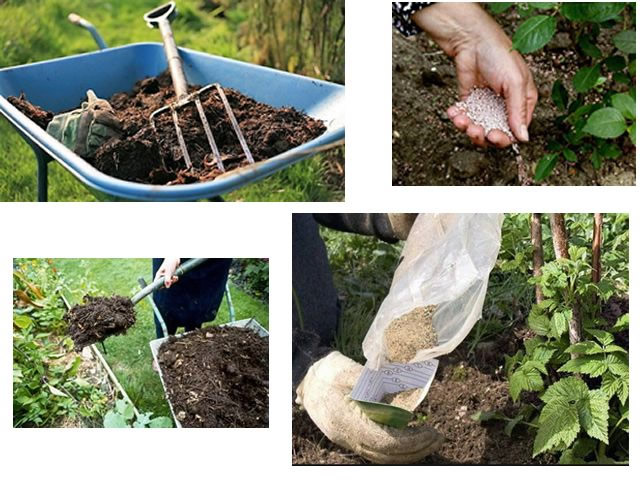
Preparing for winter
Shortly before the onset of cold weather, the raspberry tree is freed from debris, fertilized, watered if necessary and must be mulched. A thick layer of mulch protects the root system from frost. The stems are neatly tied, bent to the soil. After the first winter precipitation, they will be under a layer of snow, which will serve as a powerful protection against freezing.
In the southern regions, raspberries Bryansk ruby are not bent to the ground, and no covering materials are used. In the central strip, if necessary, use a special agrofibre.
Landing
Bryansk ruby is planted in mid-spring or autumn. When planting before winter, it must be borne in mind that the bushes need time to root, so planting is done a month and a half before the first frost.
Raspberries of the presented variety prefer sunny areas protected from gusty winds. Soil acidity also matters. Strongly acidified soil must be limed for at least two years before planting raspberries.
It is undesirable to plant raspberries Bryansk ruby:
- in low-lying areas with stagnant water;
- along buildings, blank fences;
- next to tall fruit trees.
In the shade, the Bryansk ruby grows poorly, and the berries become small and sour.
Before planting, you need to prepare the site. Both trenches (0.5 m wide, 0.4 m deep) and individual holes are suitable.
Young plants need a large amount of organic matter, complex mineral fertilizers. For 1m2 landings, up to 10 kg will be required. rotted manure or compost, 50 g of potassium salt (only in spring), 450 g of ash, 90 g of granulated superphosphate. After laying the nutrients, they wait 1-1.5 months, then start planting. In order to preserve moisture, the bushes are covered with a layer of mulch.
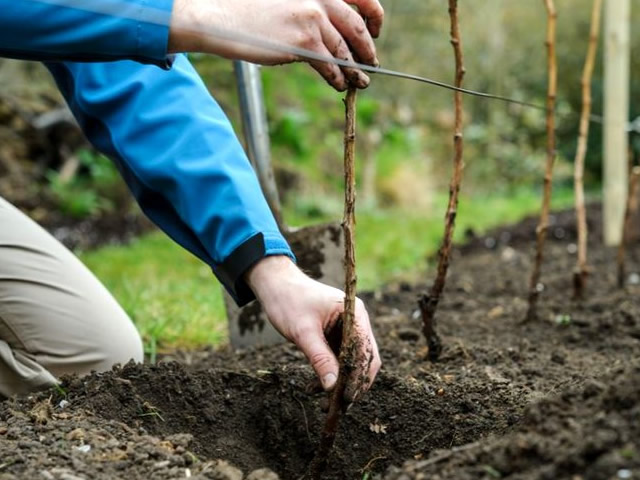
Twins of boletus: dangerous and edible
Are there false boils? This question is asked by all novice mushroom pickers. After all, it is so easy to get confused by their types, what can we say about recognizing doubles. But that's okay, since almost all of them are edible.
Butterlets can be easily confused with a pepper mushroom. But it has its own distinctive features - the absence of a ring on the leg and a red tint of the spongy layer (in oil it is more yellow). The mushroom is conditionally edible. The reason for this is its pungent taste. But unlike bitterness, it does not spoil the dishes at all. On the contrary, it is often used as a mushroom condiment.
Another double is spruce mokruha. Its young fruiting bodies are very similar to young autumn boletus. Therefore, even the most experienced mushroom pickers are misled. But one has only to take the mushroom in hand, all doubts disappear. At the spruce mokruha, on the back of the cap there are plates, not tubes. In addition, they are covered with thick mucus.
Spruce peel is an edible mushroom, although few people know about it. Usually they just throw it away.In European countries, this mushroom is valued no less than whites, but in Russia it is considered mediocre and is not taken. On the contrary, they mistakenly call it a false oiler, which is fundamentally wrong.
Another point: if this mushroom is put in a basket with other representatives of the kingdom, it will paint them lilac. Therefore, it is best to collect it separately from other mushrooms.
Ruby pepper mushroom (lat.Rubinoboletus rubinus)
Name Ruby pepper mushroom.Latin name: Rubinoboletus rubinus.Other names: Ruby oil can, Ruby Moss.Department: Basidiomycota.Class: Agaricomycetes.Order: Boletovye.Family: Boletovye.Genus: Rubinoboletus.The species is listed in the Red Book.
Edible mushroom.
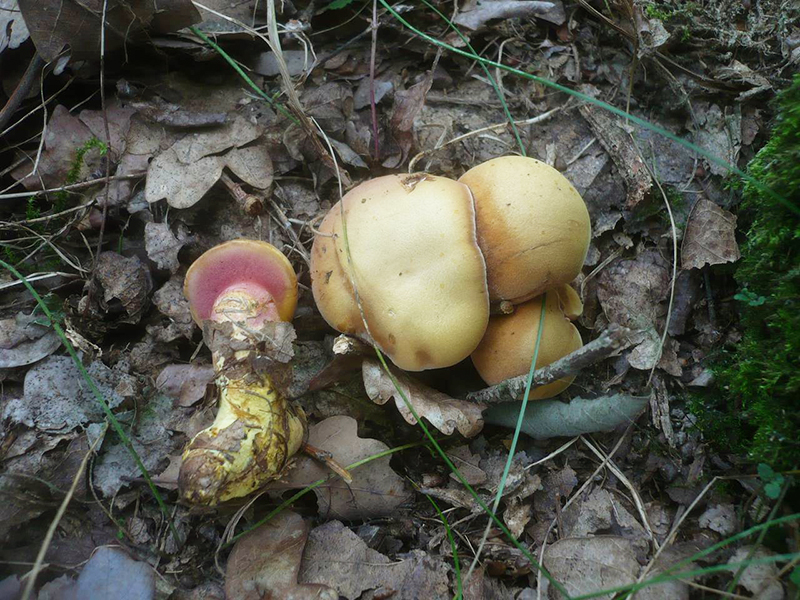 Name Ruby pepper mushroom.Latin name: Rubinoboletus rubinus.Other names: Ruby oil can, Ruby Moss.Department: Basidiomycota.Class: Agaricomycetes.Order: Boletovye.Family: Boletovye.Genus: Rubinoboletus.The species is listed in the Red Book.
Name Ruby pepper mushroom.Latin name: Rubinoboletus rubinus.Other names: Ruby oil can, Ruby Moss.Department: Basidiomycota.Class: Agaricomycetes.Order: Boletovye.Family: Boletovye.Genus: Rubinoboletus.The species is listed in the Red Book.
Edible mushroom.
Leg
30-60 mm long, 15-30 mm thick, cylindrical or clavate tapering at the base, not hollow, yellowish and covered with pink or carmine, very small granules.
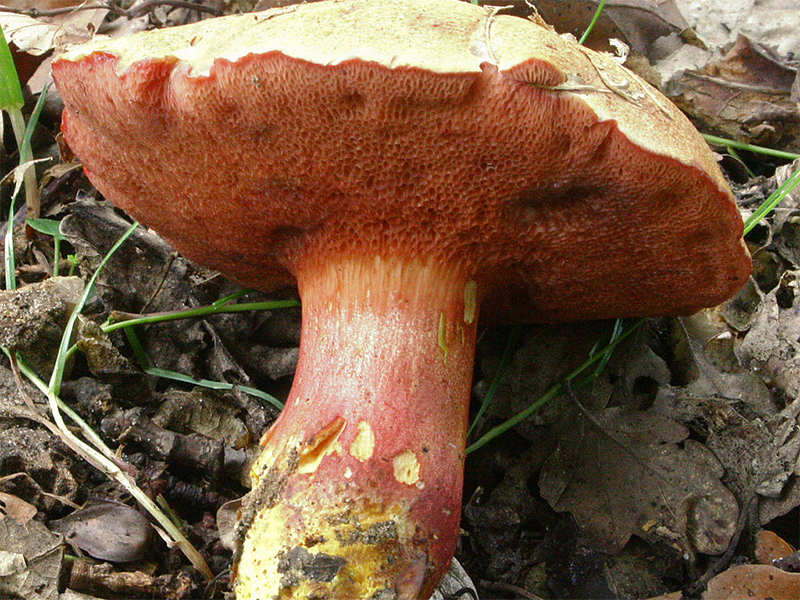
Hat
40–80 mm in diameter, spherical in young fruiting bodies, becomes convex and cushion-shaped as it grows. The skin is dry, velvety, matte, brick-colored, reddish brown to yellowish brown.
Hymenophore
Tubular, descending, carmine or pinkish-red tubules. The pores are of the same color as the tubules, roundedly elongated, do not change color when pressed.
Pulp
Yellowish, pinkish above the tubes and in the stem, at the base of the stem and under the skin of the cap, bright yellow. On the cut, the color does not change, without a pronounced taste and smell.
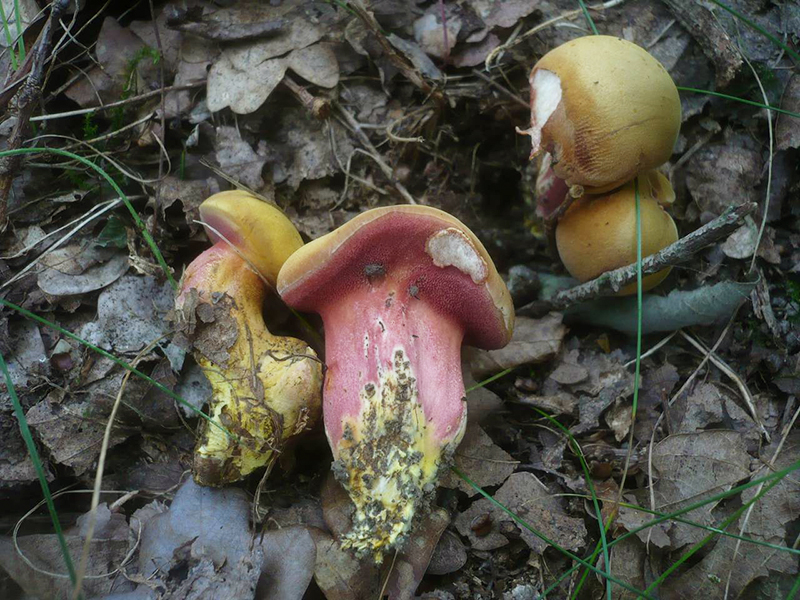
Habitat
It grows on the ground in deciduous forests, forms mycorrhiza with oaks and hornbeams. It is very rare, therefore, it is listed in the "Red Book of Russia". It is worth noting that fruiting bodies do not appear every year, this is due to the demands of this species on the temperature and humidity of the environment.
Similarity
It is similar to some species, however, due to the peculiarities of morphological characters, it is rather difficult to confuse with other species.
|
December |
January |
February |
|
March |
April |
May |
|
June |
July |
August |
|
September |
October |
November |
Butter dish (Suillus luteus)
- Other names for the mushroom:
- Ordinary butter dish
- Butter dish yellow
- Late butter dish
- Autumn butter dish
Synonyms:
- Boletus luteus
- Boletopsis lutea
Butter dish (Suillus luteus) is the scientific name of the most common type of butter. The word luteus in the scientific name of the mushroom means "yellow".
Growth:
Oily can grow on sandy soil from late May to November in coniferous forests. Fruiting bodies appear singly or most often in large groups.
External description
Hat:
The cap of the present Oily (Suillus luteus) reaches a diameter of up to 10 cm, convex, later almost flat with a tubercle in the middle, sometimes with upward curved edges, chocolate-brownish, sometimes with a purple tint. The skin is radially fibrous, very slimy and easily separated from the pulp. The tubules are initially pale yellow, later dark yellow, adherent to the peduncle, 6-14 mm long. The pores are small, in young mushrooms pale yellow, later bright yellow, brownish yellow. Tubular layer adherent to the pedicle, yellow, the pores are at first whitish or pale yellow, then yellow or dark yellow, small, rounded.
Leg:
Cylindrical, solid, 35-110 mm high and 10-25 mm thick, lemon-yellow at the top, brownish and longitudinally fibrous at the bottom. A white filmy blanket, which first connects the leg to the edge of the cap, leaves pieces on the leg in the form of a black-brown or purple ring. Above the ring, the leg is mealy.
Pulp:
The cap is soft, juicy, slightly fibrous at the stem, whitish at first, later lemon-yellow, rusty-brownish at the base of the stem.
Spore powder:
Brown.
Spores: 7-10 x 3-3.5 µm, ellipsoid-fusiform, smooth, pale yellow.
Similarity
The red butter dish (Suillus fluryi) is very similar to the real butter dish, which is distinguished by the absence of a ring on the leg. It has no resemblance to poisonous mushrooms.
Use
Real butter dish - Edible, tasty mushroom of the second category, in taste, it is very close to porcini mushrooms. It is better to remove the skin from the cap before use. It is consumed dried, fresh, pickled and salted. Delicious and easily digestible mushroom. Suitable for preparing soups, sauces and side dishes for meat dishes. To be pickled.
Spreading
The optimum average daily temperature for fruiting the oiler is + 15 ... + 18 ° C, but the ordinary oiler does not react strongly to temperature fluctuations. Fruiting bodies of boletus usually appear 2-3 days after rain, and strong dew also stimulates fruiting. In mountainous areas, boletus can grow massively around stones, this is due to the condensation of moisture on the surface of the stone. Fruiting ceases at a temperature of -5 ° C on the surface of the soil, and after freezing of the upper layer by 2-3 cm, it does not resume. In the summer (at the beginning of the season) boletus is often damaged by insect larvae, sometimes the proportion of unsuitable "wormy" boletus reaches 70-80%. In autumn, insect activity decreases sharply.
Butter dish is widespread in the Northern Hemisphere, prefers a moderately cold climate, but it is also found in the subtropics, sometimes it is accidentally introduced by humans into tropical regions, where it forms local populations in artificial pine plantations.
In Russia, boletus is widespread in the European part, in the North Caucasus, in Siberia, in the Far East. Fruiting more often in large groups.
Season June - October, massively from September.
Features of the mushroom:
Boletus edulis (boletus) are ahead of boletus edulis in terms of the content of fats and carbohydrates. Real butter dish - One of the most common types of edible mushrooms, it takes first place in its yield in coniferous forests.
Red Book
Are you here:
Home - Red Data Book of the Amur Region - Ruby Butter, Rubinoboletus
Ruby oil can, rubyboletus
Ruby oil can, ruby-boletus - Rubinoboletus rubinus (W.G. Sm.) Pilát et Demek (Suillus rubinus (W. G. Sm.) O. Kuntzc)
Category and status .. 4. Ruby buttercup species with undefined status (there is not enough information about the current state of the taxon).
A brief description of. A new species for the territory of the Russian Far East. The only known location in the Amur Region is the vicinity (W.G. Sm.) Pilát et Demek (Suillus rubinus (W. G. Sm.) O. Kuntzc)
Category and status .. 4. Species with undefined status (there is not enough information about the current state of the taxon).
A brief description of. A new species for the territory of the Russian Far East. In the Amur region, the only known location is the vicinity of the village. Oatmeal (2). The general distribution is Europe.
A brief description of. Fruit bodies are small. The cap is light yellow-brown or reddish-brown, moist, slightly slimy, then dry. The hymenophore is tubular, very brightly colored. The tubules are carmine-red, reddish-crimson, with a yellowish tinge. The leg is reddish-crimson, slightly widening at the base. The flesh of the cap is whitish, in the leg it is reddish. Spores 5.5-7 (8) x 4-6 μm (3).
Features of ecology and phytocenology. Mycorrhizal forming agent; in mixed forests (birch-larch or birch-pine). Found in a pine forest with an admixture of deciduous species. Common in parks, rare in forests.
Limiting factors. Not studied.
Condition and security measures. The species is included in the Red Book of the Russian Federation (1). It is necessary to clarify the range of the species, search for new locations, their protection and monitoring.
Sources of information. 1. Red Data Book of the Russian ..., 2008; 2. Data of the author of the essay; 3. Moser, 1967. Compiled. ON. Kochunov.
|
20.10.2015 20:44:15
Back forward
-
Menu
- home
- Photo gallery
-
Animals
- Mammals
- Birds
- Fishes
- Amphibians
- Reptiles
- Insects
- Crustaceans
- Worms
- Molluscs
-
Plants
- Angiosperms
- Gymnosperms
- Ferns
- Mosses
- Seaweed
- Lichens
- Mushrooms
- Moscow
-
Moscow region
- Mammals
- Birds
- Invertebrates
- Pisces, presm., Terrestrial.
- Plants
- Mushrooms, mosses, lichens
-
Voronezh region
- Plants
- Animals
-
Republic of Crimea
- Plants
- Animals
-
Rostov region
- Plants
- Animals
-
Krasnodar Territory
- Plants
- Animals
-
Leningrad region
- Plants
- Animals
-
Pskov region
- Plants
- Animals
-
Sverdlovsk region
- Plants
- Animals
-
Saratov region
- Mushrooms
- Bryophytes
- Ferns
- Amur region
- Krasnoyarsk Territory
- Belgorod region
-
Chelyabinsk region
- Plants
- Animals
-
IUCN Red List
- Extinct mammals
- Rare birds of the world
- Cetaceans
- Carnivores
- Reserves of Russia
- Wild animals
- Birds of Russia
- Download the Red Book
- Basic documents
- Custom sog.
- .
Description of the mushroom
It also has such names as Butter dish or Peppermint, in Latin - Xerocomus piperatus, Boletus piperatus or Suillus piperatus. The pepper mushroom belongs to the genus Chalciporus, the Boletov family.
The hat has a rounded shape, convex, and becomes flat with age. It reaches 7 cm in diameter, is smooth, there is a small amount of sticky mass on the surface. The color ranges from light brown to dark rusty and even reddish. It is impossible to remove the skin from the surface.
The hymenophore is tubular (the cap is on the underside), often adherent, less often descending. The color is brown, with a reddish tint, the shape of the tubes is angular. The spores are brownish, elongated.
The flesh of the mushroom is loose, yellowish, gray-yellow at the stem. It turns slightly red on the cut. The taste is spicy, with a pronounced peppery flavor.
The leg grows up to 8 cm, up to 1.5 cm in diameter, has a cylindrical shape, often curved and narrowed at the bottom. Its pulp is solid, dense. The color completely coincides with the tone of the cap, less often slightly lighter, yellowish closer to the base.
The first to mention the pepper mushroom was the French physician and botanist Jean Baptiste François Pierre Bullard. He became the author of a number of botanical taxa, researched the flora, wrote the book "History of French mushrooms".
Seasoning recipe
The seasoning made from dried pepper oil is popular among amateur chefs and professional chefs. The process of its manufacture is simple, it can be reproduced at home, following the following instructions:
- peel and rinse the mushrooms thoroughly;
- break the legs and caps into pieces;
- cook for 1.5-2 hours, you can change the water in the process;
- drain the water and dry the oil in the oven for 3-4 hours;
- be sure to turn over during drying;
- grind into powder in any way;
- re-place in the oven for a few minutes.
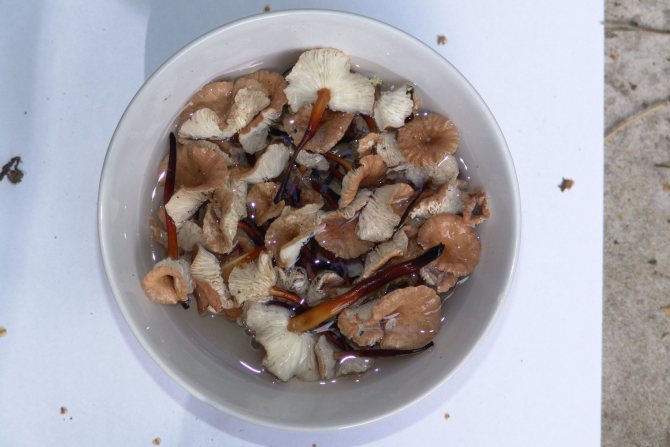
Preparing mushrooms for cooking Ready seasoning should be stored in a sealed container, preferably glass. Such a seasoning, when added to food, will have a hot pepper and mushroom aroma at the same time.
Description of the variety
The bushes of the Bryansk ruby are powerful, strong, up to 200 cm high. At the same time, they are quite compact, no more than 5 shoots are formed on one plant, which greatly simplifies the care of raspberries.
The stems are erect, they can do without a trellis. However, to simplify maintenance and ease of harvesting, summer residents still prefer to build supports. In addition, the trellis allows you to increase yields and get more berries in a limited area of small garden plots. There are thorns on the shoots, but there are not many of them. The foliage is medium in size, rich emerald color, wrinkled.
The Bryansk ruby does not need bee pollination. The berries are sweet, with a bright ruby hue, blunt-conical in shape. Their weight reaches 3-5 g. The variety is recommended not only for household plots, but also for commercial cultivation. With good care, the yield of the variety is up to 50 centners per hectare. On a vegetable garden scale, it is about 2-3 kg. from the bush. After ripening, the berries do not flow, remain strong, and tolerate transportation well. The pulp of the fruit is tender, sweet, aromatic, contains 9.5% sugars, 1.6% acids and 25 mg% vitamin C. The tasting score of the berries is 4.5 points out of 5.0 possible.
Dessert raspberries Bryansk ruby are consumed fresh and in different types of preparations.
The variety is frost-resistant, not sensitive to a number of diseases, but it is easily affected by spider mites. In order to prevent early spring, spraying with special chemicals is mandatory.
The variety is included in the State Register for the Central Region, it belongs to the varieties with an average ripening period.


